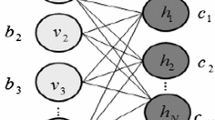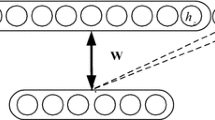Abstract
Restricted Boltzmann machines (RBMs) are efficacious undirected neural networks for generating features and reconstructing images. Nevertheless, the classical persistent chain sampling algorithm has the problem of refactoring failure in the early training stage, which significantly limits the feature extraction and application of RBM. In this paper, motivated by the cumulative nature of the curriculum learning, three Phased Gibbs Sampling (PGS) methods are proposed for more efficient feature extraction and reconstruction by training the RBM periodically. Then, to achieve an automatic and exclusive training step, the innovative Improved Dynamic Learning Rate (IDLR) is designed by cooperating with the reconstruction error and the anti-vibration coefficient. Extensive experimental results of MNIST, 20 Newsgroup, Olivetti face, MNORB, and USPS demonstrate the superiority of three PGS-IDLR algorithms in terms of reconstruction error, training time, and classification accuracy. More specifically, the proposed algorithms can improve the classification accuracy by at least 2% and shorten the training time, compared with the state-of-the-art approaches. Moreover, they achieve a better performance in log-likelihood indictor and image reconstruction.
























Similar content being viewed by others
References
Bengio Y (2009) Learning deep architectures for ai. Foundations and trends?. Mach Learn 2:1–127
Bengio Y, Louradour J, Collobert R, Weston J (2009) Curriculum learning, the 26th Annual International Conference on Machine Learning, pp 41–48
Brakel P, Dieleman S, Schrauwen B (2012) Training restricted Boltzmann machines with multi-tempering: Harnessing parallelization. European Symposium on Artificial Neural Networks, Computational Intelligence and Machine Learning, pp 287–292
Cai D, He X, Han J, Zhang H (2006) Orthogonal laplacianfaces for face recognition. IEEE Trans Image Process 15:3608–3614
Cho K (2011) Enhanced gradient and adaptive learning rate for training restricted boltzmann machines. Proceedings of the 28th International Conference on Machine Learning
Cho K, Raiko T, Ilin A (2010) Parallel tempering is efficient for learning restricted Boltzmann machines. Int Joint Conf Neural Netw:3246–3253
Coates A, Ng AY, Lee H (2010) An analysis of single-layer networks in unsupervised feature learning. International Conference on Artificial Intelligence and Statistics
Desjardins G, Courville A, Bengio Y (2010) Adaptive parallel tempering for stochastic maximum likelihood learning of RBMs. Advances in Neural Information Processing Systems Workshop on Deep Learning and Unsupervised Feature Learning
EHinton GE (2002) Training products of experts by minimizing contrastive divergence. Neural Comput 14:1771–1800
EHinton GE (2006) Reducing the dimensionality of data with neural networks. Science 313:504–507
Elman JL (1993) Learning and development in neural networks: the importance of starting small. Cognition 48:71–99
Fakhari A, Kiani K (2021) A new restricted boltzmann machine training algorithm for image restoration, Multimed Tools Appl 80, 2047–2062
Fatemi M, Safayani M (2019) Joint, sentiment/topic modeling on text data using a boosted restricted Boltzmann Machine. Multimed Tools Appl 78:20637–20653
Fischer A, Igel C (2011) Parallel tempering, importance sampling, and restricted Boltzmann machines. The 5th Workshop on Theory of Randomized Search Heuristics
Fischer A, Igel C (2014) Training restricted Boltzmann machines: An introduction. Patern Recogn 47:25–39
Hinton G (2012) A practical guide to training restricted Boltzmann machines. Momentum 9:599–619
Hinton G, Salakhutdinov R (2009) Replicated softmax: an undirected topic model. NIPS, pp 1607–1614
Hinton G, Osindero S, Teh YW (2016) A fast learning algorithm for deep belief nets. Foundations and Trends?. Neural Comput 18:1527–1554
Hinton G, Deng L, Yu D, Dahl GE, Mohamed A, Jaitly N (2012) Deep neural networks for acoustic modeling in speech recognition: the shared views of four research groups. Signal Process Mag IEEE 29:82–97
Hongmei W, Pengzhong L (2021) Image recognition based on improved convolutional deep belief network model. Multimed Tools Appl 80:2031–2045
Jiang L, Meng D, Zhao Q, Shan S, Hauptmann AG (2015) Self-paced curriculum learning. Twenty-Ninth AAAI Conference on Artificial Intelligence
Koller D, Friedman N (2009) Probabilistic graphical models: Principles and Techniques. MIT Press
Krueger KA, Dayan P (2009) Flexible shaping: How learning in small steps helps. Cognition 110:380–394
Kumar MP, Packer B, Koller D (2010) Self-paced learning for latent variable models. Advances in Neural Information Processing Systems
Lang K (1995) Newsweeder: Learning to filter netnews. Machine Learning, Proceedings of the Twelfth International Conference on Machine Learning, pp 331–339
Larochelle H, Bengio Y (2008) Classification using discriminative restricted Boltzmann machines. Machine Learning Proceedings of the Twenty-Fifth International Conference
Lecun Y, Bengio Y, Hinton G (2015) Deep learning. Nature 521:436
Lėcun Y, Bottou L, Bengio Y, et al. (1998) Gradient-based learning applied to document recognition. Proc IEEE 86:2278–2324
Lėcun Y, Huang FJ, Bottou L (2004) Learning methods for generic object recognition with invariance to pose and lighting: Computer Vision and Pattern Recognition. Proceedings of the 2004 IEEE Computer Society Conference
Li F, Gao X, Wan K (2016) Research on RBM training algorithm based on dynamic Gibbs sampling. Acta Autom Sin 42:931–942
Li F, Gao X, Wan K (2017) Research on RBM networks training based on improved parallel tempering algorithm. Acta Autom Sin 43:753–764
Luo L, Wang Y, Peng H, Tang Z, You S, Huang X (2016) Training restricted Boltzmann Machine with dynamic learning rate. International Conference on Computer Science and Education. IEEE
Medhat F, Chesmore D, Robinson J (2017) Recognition of acoustic events using masked conditional neural networks. 16th IEEE International Conference on Machine Learning and Applications
Neal RM (1992) Connectionist learning of deep belief networks. Artif Intell 56:71–113
Rohde D, Plaut D (1999) Language acquisition in the absence of explicit negative evidence: How important is starting small. Cognition 72:67–109
Sailor HB, Patil HA (2016) Unsupervised learning of temporal receptive fields using convolutional RBM for ASR task. IEEE 24th European Signal Processing conference(EUSIPCO)
Salakhutdinov R (2015) Learning deep generative models. Ann Rev Stat Appl 2:361–385
Salakhutdinov R, Hinton G (2009) Deep boltzmann machines. J Mach Learn Res 5:1967–2006
Salakhutdinov R, Murray I (2008) On the quantitative analysis of deep belief networks. International Conference on Machine Learning
Sanger TD (1994) Neural network learning control of robot manipulators using gradually increasing task difficulty. IEEE Trans Robot Autom 10:323–333
Schwenk H, Gauvain J. -L. (2002) Connectionist language modeling for large vocabulary continuous speech recognition. International Conference on Acoustics Speech and Signal Processing
Spitkovsky VI, Alshawi H, Jurafsky D (2010) From baby steps to leapfrog: how “less is more” in unsupervised dependency parsing. NAACL
Swersky K, Bo C, Marlin B, Freitas ND (2010) A tutorial on stochastic approximation algorithms for training. Restricted Boltzmann Machines and Deep Belief Nets Information Theory and Applications Workshop
Tang Y, Salakhutdinov R, Hinton G (2012) Robust boltzmann machines for recognition and denoising. In: 2012 IEEE Conference on computer vision and pattern recognition, pp 2264–2271
Tehrani AA, Nickfarjam AM, Ebrahimpour-komleh H et al (2021) Multi-input 2-dimensional deep belief network: diabetic retinopathy grading as case study. Multimed Tools Appl 80:6171–6186
Tieleman T (2008) Training restricted Boltzmann machines using approximations to the likelihood gradient. Int Conf Mach Learn:1064–1071
Tieleman T, Hinton G (2009) Using fast weights to improve persistent contrastive divergence. International Conference on Machine Learning
Wang Q, Gao X, Wan K, Li F, Hu Z (2020) A novel restricted boltzmann machine training algorithm with fast gibbs sampling policy. Mathematical Problems in Engineering
Wu Q (2020) Image retrieval method based on deep learning semantic feature extraction and regularization softmax. Multimed Tools Appl, 79, 9419–9433
Zhao Y, Chen Y, Tu K, Tian J (2017) Learning bayesian network structures under incremental construction curricula. Neurocomputing 258:30–40
Acknowledgements
The authors are grateful to Professor Gao for the discussions on this topic. This study was supported by the National Natural Science Foundation of China (Grant no. 61573285) and Natural Science Foundation of Shaanxi Province (Grant no. 2020JQ-220).
Author information
Authors and Affiliations
Corresponding author
Ethics declarations
Conflict of Interests
The authors declare that they have no conflicts of interest.
Additional information
Publisher’s note
Springer Nature remains neutral with regard to jurisdictional claims in published maps and institutional affiliations.
Rights and permissions
About this article
Cite this article
Wang, Q., Gao, X., Li, X. et al. A precise method for RBMs training using phased curricula. Multimed Tools Appl 82, 8013–8047 (2023). https://doi.org/10.1007/s11042-022-12973-2
Received:
Revised:
Accepted:
Published:
Issue Date:
DOI: https://doi.org/10.1007/s11042-022-12973-2




